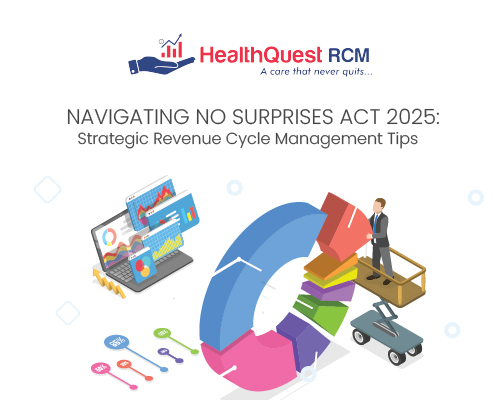The No Surprises Act 2025 introduces significant changes that impact healthcare providers and their revenue cycle management strategies. Ensuring compliance while maintaining revenue protection requires a structured approach. This guide provides essential insights and strategies to help healthcare organizations navigate the evolving regulatory landscape effectively.
Key Changes in No Surprises Act 2025 Impacting Revenue Cycle Management
The No Surprises Act 2025 builds upon existing legislation, introducing stricter enforcement policies and transparency mandates. Compared to previous versions, it expands patient protections, enforces stricter compliance audits, and increases financial penalties for non-compliance. Healthcare providers must adapt to:
- Expanded protections for patients against unexpected medical bills, including new dispute resolution mechanisms.
- Enhanced reporting and disclosure requirements to ensure full transparency.
- Increased penalties for non-compliance, making regulatory adherence more critical than ever.
- Greater scrutiny on revenue cycle management practices, requiring providers to refine their billing and financial workflows.
Understanding these changes is the first step toward aligning financial operations with compliance standards.
Step-by-Step Compliance Checklist to Avoid Penalties and Audits
To mitigate financial risks, healthcare providers should follow this compliance checklist, ensuring they stay ahead of regulatory enforcement:
- Review Billing Policies: Ensure all patient billing practices align with No Surprises Act 2025 regulations.
- Enhance Price Transparency: Provide clear upfront cost estimates to patients before services are rendered.
- Audit Claims Processing: Regularly review billing processes to identify and rectify potential compliance gaps.
- Train Staff on Compliance: Educate billing and administrative teams about updated regulatory requirements to prevent costly errors.
- Establish a Dispute Resolution Plan: Create a structured process to handle patient billing disputes efficiently and in compliance with federal guidelines.
- Monitor Regulatory Updates: Stay informed about future amendments and industry best practices through industry associations and compliance workshops.
Revenue Optimization Strategies Aligned with Transparent Patient Billing Practices
Revenue protection and compliance can coexist by implementing proactive revenue cycle management strategies:
- Automate Revenue Cycle Processes: Utilize technology to streamline billing, claims submission, and reimbursement workflows, reducing manual errors.
- Improve Patient Financial Engagement: Offer clear payment options, financial counseling, and upfront cost breakdowns to prevent disputes and increase collections.
- Optimize Coding and Documentation: Accurate medical coding reduces claim denials and revenue loss while ensuring compliance.
- Leverage Data Analytics: Monitor financial metrics and compliance adherence to improve decision-making and prevent revenue leakage.
Case Studies: Providers Who Maximized Revenue Through Proactive NSA Compliance
Several healthcare organizations have successfully adapted to No Surprises Act regulations while enhancing revenue protection.
Case Study 1: Large Hospital Network
A multi-state hospital group implemented automated billing verification systems, reducing compliance-related claim denials by 35% and increasing patient payment collections by 20%. By proactively updating their revenue cycle management processes, they avoided regulatory penalties while maintaining financial stability.
Case Study 2: Independent Medical Practice
A specialty clinic integrated transparent pricing structures and automated patient cost estimations, leading to a 25% decrease in patient billing disputes and improved overall patient satisfaction. Their compliance-first approach helped them strengthen patient trust and streamline revenue cycles.
Future-Proofing Revenue Cycle Management with Continuous Regulatory Readiness
To sustain compliance and revenue stability, healthcare providers must:
- Invest in Advanced Billing Technology: AI-driven billing solutions enhance accuracy and compliance, reducing manual errors.
- Develop a Compliance Task Force: Assign dedicated teams to oversee regulatory adherence and audit financial workflows.
- Engage in Industry Advocacy: Stay connected with professional associations and regulatory bodies to anticipate policy changes and participate in shaping industry standards.
- Regularly Update Compliance Training: Keep staff informed about emerging regulations, best practices, and compliance requirements to avoid penalties.
By implementing these measures, organizations can safeguard their financial health while delivering patient-centric care and maintaining compliance with the No Surprises Act 2025.
Preparing for Compliance
Navigating the No Surprises Act 2025 requires a proactive approach to compliance and revenue cycle management. By implementing transparent billing practices, leveraging automation, and staying updated with regulatory changes, healthcare providers can mitigate financial risks while ensuring compliance. Organizations that prioritize patient engagement and structured financial workflows will be better equipped to handle audits, optimize revenue, and enhance patient trust.
FAQ Section
The No Surprises Act 2025 is an updated federal law designed to protect patients from unexpected medical bills and enforce stricter compliance measures for healthcare providers.
The law mandates transparency in billing, increases compliance requirements, and imposes penalties for non-compliance, affecting how providers manage their revenue cycles.
Key requirements include upfront cost estimates, transparent billing practices, dispute resolution mechanisms, and adherence to revised claims processing guidelines.
By automating billing processes, improving patient financial engagement, optimizing coding accuracy, and leveraging data analytics, providers can protect revenue while ensuring compliance.
Non-compliance can result in financial penalties, legal consequences, and reputational damage, making it crucial for healthcare organizations to adhere strictly to the regulations.

